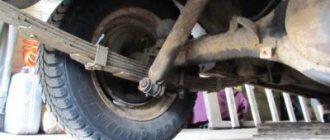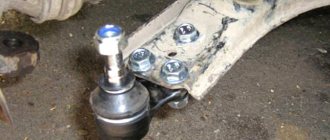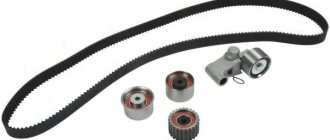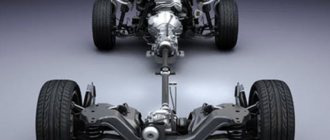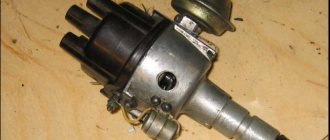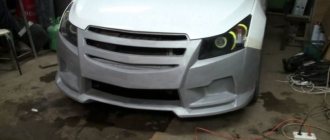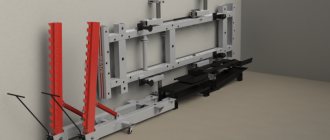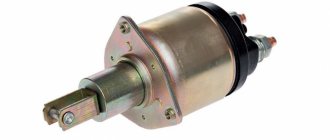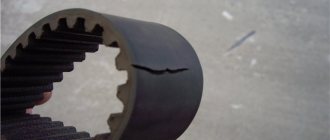A modern car is a complex mechanism consisting of many structural parts and assemblies. Among them are the cooling system (SOD), gearbox (Gearbox), etc. One of the most important parts is the timing belt. What kind of mechanism is this and how does it work?
What is a timing belt ? This is a closed rubber ring of a specific diameter, which has special notches on the inside. Due to the fact that the timing belt consists of rubber, it is practically silent and absolutely not subject to corrosion, but there are also negative aspects. Due to the constant force of friction on the pulleys, unpleasant moments such as a broken timing belt often occur, after which the car owner will have to spend money and change the timing belt .
When and how to change the V-belt.
The main problem in a car when the drive belts wear out at the initial stage are various creaks and whistles that occur during the rotation of the pulleys transmitting torque to the engine attachments. If these creaks and whistles occur, one of the drive belts may simply break soon. Dear friends and our readers, we offer you detailed information about the types of belts installed in modern cars. Our information directory will help you find out when it is necessary to change drive belts and also how to determine the degree of their wear, how a drive belt differs from a timing belt and what is the average cost of drive belts on the Russian market, and at the same time get for yourself and answers to other questions that interest you directly related to these belts.
First, let's immediately dot the i's and find out what they are - drive belts.
A car drive belt is an element of a belt drive, a specific working part of vehicles and mechanisms that serves to transmit engine torque.
The transmission of torque occurs due to frictional forces or engagement forces (timing belts, V-belts).
There is a misconception that the timing belt (timing belt drive) is not a drive belt. Actually this is not true. The timing belt also falls into the category of drive belts.
Drive belts are divided into several types, namely:
— Timing belt (timing belt drive).
— Drive belts for auxiliary components (engine attachments).
There are 3 (three) types of car belts:
1. Timing belt - as a rule, it is toothed.
2. Poly V-belt transmitting engine torque to engine attachments.
3. V-shaped (V-belt) transmission of engine torque to engine attachments.
Belts No. 2 and No. 3 in our country also have additional names, that is: flat belt (V-ribbed belt) or ripple belt (V-belt).
Unlike timing belts, which are subject to fairly strict requirements, such as mandatory timely scheduled replacement in accordance with the service life established by the manufacturer, drive belts that ensure the operation of engine auxiliary (attachment) equipment do not require such close attention.
But, nevertheless, this does not mean at all that they do not need our attention. They also periodically require scheduled replacement. Moreover, it is not advisable to wait until the belts fail, since these belts ensure the operation of important equipment in the car (cooling, battery charging, air conditioning, etc.).
Thus, if you suddenly hear a squeak or whistle under the hood of your car, we advise you to pay attention to it. Remember that extraneous noise under the hood is not only a nuisance for your hearing, but also something more. If a creaking or whistling noise appears under the hood of the car, this indicates that the drive belt is slipping on the pulleys. For example, if the belt is old, then its tension may be significantly weakened, which causes the belt to slip on the pulleys and produce a squealing noise while the engine is running.
Typically, when a belt is worn out or has loose tension, the slipping or squealing will only worsen in rainy and cold weather as the belt loses its grip on the pulley due to moisture.
If you, friends, heard a single squeak or whistle of a belt under the hood of your car, especially after driving through a deep puddle, then there is no particular reason to worry. In this case, the drive belt is most likely too wet, which has reduced its adhesion specifically to the pulley. If you hear this whistle (squeal) under the hood after starting the car in the morning or after several kilometers, or after starting to drive, or when the engine warms up, then most likely your drive belts (or belt) are worn out or weakened the tension of these drive belts itself.
V-belt drive
The cross section of the V-belt is a trapezoid. Its form is standardized. On the territory of Russia, the configuration of a standard wedge is described by the requirements of GOST 1281.1-89, 1281.2-89, 1281.4-89. Narrow-profile products are standardized according to TU 38-40534-75, 38-105161-84.
V-belts have many advantages.
- The surface area of contact with the pulley, compared to the width of the product, is huge. Good adhesion and the formation of significant friction forces are ensured.
- To transmit torque, it is not necessary to create a large tension; the load on the shafts and supports is reduced.
- The distance between the shafts can be as small as desired, which is valuable in modern machines and mechanisms.
- Stable power transmission is ensured, the tape has no crosslinks. This is a valuable property in high precision drives.
To adjust the V-belt drive, simply move the engine on a special slide. In addition, several belts can be installed in the drive system to distribute the total load between them.
This type of transmission has a number of disadvantages. Firstly, the wedge profile creates high rigidity. The service life of the product is limited, especially when there are load surges on the driven shaft. Secondly, special mechanics for installing the belt on the pulleys are needed. In addition, there is no universality of use. A specific group of mechanisms uses only a certain type of element with a wedge profile.
Function of the drive belt (V-V and poly V-belt)
A V-shaped or poly-V belt is part of the engine drive belts, which serves as an auxiliary component that ensures the functionality of the attachments of the car’s power unit (water pump, air conditioning, generator, hydraulic booster).
The belt rotates due to the torque of the engine during operation. Torque is initially transmitted by the crankshaft of the engine itself. Next, the torque is transmitted through belts and pulleys to auxiliary equipment located under the hood.
For example, a V-belt has a V-shaped cross section, which allows the belt to transmit torque to the vehicle accessory pulleys. This type of belt drive is called V-belt torque transmission.
For example, this type of belt is often used to transmit engine torque to an electric generator that charges the battery.
The rotation of the generator produces electricity, which supports the operation of all electrical equipment in the vehicle.
Also, in many modern cars, this type of belt is also used to transmit torque to the electric power steering, to the cooling fan, to the water pump (coolant pump), to the air conditioning compressor and to the classic power steering wheel. Since this belt is subjected to enormous loads and constant temperature changes, it is made, as a rule, of hard rubber and a metal core, which provides strength and durability to the belt. Also, many belts have a durable textile thread, which allows the belt to withstand the transmission of high torque.
So, friends, remember, each car, in addition to the timing belt (some cars also use a timing chain), has one or more belt drives (depending on the technical features of the car), which ensure the functionality of engine attachments.
Definition
Belt
is an endless belt that transfers power from the drive shaft to one or more driven shafts. The system works on the following principles:
- the belt is located on pulleys;
- power transmission and torque formation occurs due to the action of friction forces;
- For effective operation of the belt drive, tension on the working element must be ensured.
Toothed types of drive belts transmit torque not only by frictional forces, but also by engaging the protruding elements with the protrusions on the pulley wheel. Each of the currently used transmission elements has its own list of advantages and disadvantages.
If the drive belt is cracked.. (consequences)
If the drive belt (or belts) in your car are worn out, they will have cracks and abrasions on their surface. Eventually, while the car is moving, a whistle will begin to appear. In this case, it should be clear that the time has come for their planned replacement. Remember, friends, that if you do not change the drive belt on time, you risk being left without working car equipment. For example, if a belt has reached the end of its service life due to severe wear and tear, it will naturally break sooner or later.
Typically, when the drive belt breaks, you will hear a loud bang from under the hood. As a result, the equipment receiving torque from it will cease to function. For example, if the drive belt that powers the generator breaks, it will simply stop charging the battery and powering all the electrical equipment of the car. As a result, you will see the battery icon light up on the car dashboard.
Also, if the belt breaks, the power steering will stop working. As a result, your steering wheel will become very difficult to turn. But the most important problem when the drive belt breaks is the lack of rotation transmission to the water pump, which promotes the circulation of coolant through the engine cooling system. As a result, the engine can quickly overheat. In this case, you must immediately stop driving, stop and turn off the engine.
Therefore, friends, while driving, constantly monitor the engine temperature sensor, which should show the same temperature of 90 degrees after the engine warms up. If you notice that the temperature needle on the device has gone up and is approaching the dangerous red zone, then in this case you need to stop, turn off the engine and diagnose the cooling system.
Attention! Overheating of the engine can lead to its premature failure (damage to valve stem seals, head gaskets, and also damage to the piston system). Therefore, friends, do not under any circumstances allow the power unit to overheat; monitor the engine temperature on the dashboard.
What determines the service life of drive belts?
Modern drive belts have a fairly long service life, all thanks to their design and modern reliable materials. On average, a high-quality belt can last up to 25 thousand hours of operation. Please note that the service life is indicated in hours, and not in kilometers, since the mileage itself does not directly affect the service life of the drive belts. After all, these belts are in motion even when the car is standing still and the engine is idling.
But this is in theory and according to information provided by the belt manufacturers themselves to consumers.
In practice, the service life of drive belts may differ significantly from that declared by the manufacturer. The point is that the wear of drive belts is influenced by many different factors. For example, the way it was installed on the car plays an important role in the long service life of belts. For example, it is not uncommon for car mechanics in technical centers, due to their low qualifications or lack of experience in car repairs, to try to fit a belt onto a pulley using a screwdriver. Ultimately, the new belt will become damaged and will no longer last as long as the manufacturer claims. This method of installing a drive belt is also used when it is necessary to speed up the process of replacing it, so as not to remove the pulley.
In addition, the service life of belts is also affected by the storage conditions of these components in the warehouse and during their transportation. For example, it is not uncommon for car dealerships to sell drive belts that have expired. Yes, drive belts certainly have an expiration date. The point here is this: the chemical composition of the materials of drive belts changes over time, and if the drive belt was produced 5 years ago and was incorrectly stored in a warehouse, then when installed on a car it will naturally not last very long.
Weather can also affect the durability of belts in a car. For example, if you live in a region with a hot climate, then you often use air conditioning. This means that the air conditioning compressor must then receive more of the required energy. As a result, this belt, which transmits torque to the air conditioning compressor, begins to experience increased load.
In particular, drive belts can quickly wear out if the machine is operated for a long time in cold and damp weather. For example, in winter, the electrical equipment of a car requires more power than in warm and dry weather.
As a result, the alternator requires more energy to maintain the electrical system in the vehicle. Ultimately, the alternator belt begins to experience increased stress due to increased torque.
As a rule, these drive belts last longer in a new car because they were installed at the factory and all the necessary storage conditions were observed before they were installed. Once the factory drive belts are replaced, the service life of the newly installed belts will be reduced.
Each car manufacturer in the technical documentation and in the car service book usually indicates in routine maintenance the date when it is necessary to regularly replace the drive belts. Therefore, we advise you, friends, to carefully read the list of scheduled technical inspections and the regulations for replacing consumables. As a rule, the manufacturer indicates the maximum mileage at which the drive belts must be replaced at a car mechanic's technical center. Thus, you will approximately know for yourself the maximum service life of drive belts. But this does not mean that you should not regularly inspect the condition of the belts. More on this below.
Regularly checking drive belts
Periodically, every car owner should check the condition of all drive belts and their tension. To do this, check the belts with your finger while the engine is off. For example, by pressing your finger on the belt, you can understand for yourself whether the belt drive tension has loosened or not. Remember that the belt should not move during this inspection (move 1 - 2 cm). If you see something like this, then the cause is weak belt tension. You should also inspect the belt by touch for damage, and a visual inspection is also necessary for chips, cracks and torn elements on the belt.
To do this, use a flashlight, which will not only make your vision better, but can also help you identify worn areas on the belt (as a rule, worn areas of the belt will shine).
In any case, if you see damaged areas on the belt, then it must be replaced with a new one. Please note that when purchasing new drive belts you do not need to purchase original consumables. Today there are many non-original belts on the market, which are often even superior in quality to factory originals. For example, it has proven itself to be the largest supplier of drive belts.
The average cost of replacing a belt in a car repair shop is approximately 2,500 thousand rubles. The cost of car belts itself depends on the popularity of the brand and the cost of the product. There are both cheap drive belts on the market and expensive ones that have a special design and are able to withstand extreme loads.
Breakage features for 8- and 16-valve vehicles
It should be noted that the more complex the design of the motor, the more serious the consequences will be for it if the belt breaks. So, on conventional 8-valve internal combustion engines, you can get away with simply replacing the device. At the same time, on a 16-valve engine it is necessary to completely restore damaged valves and pistons (that is, replace them). But this does not mean that driving 16-valve cars is very dangerous and that they are unsuitable for long journeys. If you regularly monitor its external condition, you will definitely not be in danger of breaking the belt. Also, when inspecting the gear element, it is recommended to pay attention to the condition of the camshaft and crankshaft seals for leaks, and also to check the serviceability of the tension rollers. Remember that the malfunction of these elements significantly affects the life of the belt.
How to tension, tighten or loosen a drive belt
If the cause of the whistle, squeal or squeak is actually a belt that has become loose and as a result slips on the pulleys, and if the belt does not have any signs of wear or damage, then to remove the extraneous sound you just need to tighten the belt.
Using the same example of a generator belt, this is done using a special adjusting bolt (on modern cars) or using an adjusting bar (on older cars).
For example, to tighten the alternator belt on a modern car, you need to do the following:
— Slightly loosen the generator mounting bolts (upper and lower fastenings).
— Turn the adjusting bolt clockwise, thereby moving the generator away from the engine block and immediately check the belt tension level.
— Then, tighten the nuts of the generator fastening elements.
Please note that in some vehicle systems, the process of tensioning the drive belts is too labor-intensive and requires the use of special tools.
Attention . New generation poly-V-ribbed elastic belts are currently widespread on the market, as well as in many cars. For example, one of the world's well-known manufacturers of such belts is currently. Their products have proven themselves to be the best today. This company is an official supplier for many car factories. Elastic poly V-belts do not require tensioning, tightening, etc. manipulation. Due to their design and material, such belts do not stretch. As a rule, such drive belts last a long time, approximately 120 thousand kilometers.
But for its (their) initial tension a special tool is needed.
In many cars, special belt tension rollers are also used for this, which saves drivers from constantly tightening these belts. The only drawback of this design, as a rule, is that when replacing drive belts, it is also necessary to change the tension roller itself, since its reuse together with a new belt is impossible.
Flat drive transmission
Flat drive transmission is the oldest torque transmission scheme. The installations use:
- pulleys in the form of smooth cylinders;
- thin ribbons, the cross-section of which is a rectangle.
In ancient times, raw leather was an indispensable material for the manufacture of transmission elements. Today, flat belts are made from several layers of rubber. To increase strength, a cord of textile thread or nylon is placed inside the structure.
Flat drive transmission has several advantages. Firstly, it allows you to quite simply organize the transmission of torque not only between parallel, but also shafts intersecting at any angle. Secondly, the design of pulley wheels is extremely simple. Thirdly, a flat tape with a small thickness is highly flexible and experiences low stress during bending and deformation
But there are also significant disadvantages in using such a transfer. The main thing is the need to provide a significant tension force to generate friction force. As a result, the service life of the belt is reduced. In addition, the drive and driven shafts operate under significant load, and the bearing blocks have significant wear.
Today, to make a flat belt, rubber with reinforcement from belting fabric material, polymers, and metal cord is used. Drive systems use rubberized fabric belts. Threaded elements with layers of rubber, wrapped in layers or spirally, are used.
Replacing drive belts at a technical center
Modern cars today are equipped with sophisticated technologies and new complex engines with additional equipment. Most modern vehicles have very, very little space under their hood. In some cars there is simply no free space under the hood. Therefore, replacing drive belts in new cars yourself is not so easy. After all, in order to replace drive belts, it is necessary to dismantle many attachments. And all this just to get to the belts themselves.
Typically, replacing drive belts along with rollers may take about 1.5 - 2 hours. The average cost of an hour in Russia is currently about 35 - 50 US dollars. Accordingly, the cost of replacing belts can range from approximately 2,500 to 9,000 thousand rubles (depending on the technical center, make and model of the car).
In older cars, the process of replacing drive belts usually lasts no more than half an hour, since due to the simpler design of the engine compartment, access to the rollers and belts is more convenient.
Selecting the type of gearbox
In order to decide on the type of gearbox, you need to consider the spatial arrangement of all the mechanisms that are attached to the gearbox, their mounting locations and installation methods.
- Helical gearboxes:
- The horizontal type of such a gearbox is suitable for schemes in which the axes of the input and output shafts are parallel to each other and at the same time are in the same plane (namely, horizontal);
- For a vertical cylindrical type, the gearbox axes must be located in the same vertical plane;
- The planetary or coaxial cylindrical type is used when the shaft axes are in different planes, but are located on the same straight line.
- Helical-bevel gearboxes are used only for those schemes where the shaft axes are in the same plane (horizontal) and perpendicular to each other.
- Worm gearboxes:
- The axes of a single-stage worm gearbox must intersect at right angles and lie in different planes;
- In a two-stage worm gearbox, the shaft axes intersect at right angles or are parallel to each other, but at the same time they necessarily lie in different planes.
Moreover, depending on the application of the gearbox, factors such as:
- Operation volume (the “quiest” is a worm gearbox);
- Efficiency or efficiency (planetary gearboxes are considered the most efficient in terms of operation, while two-stage worm gearboxes have the lowest efficiency);
- Cost in relative terms (planetary gearboxes are considered the most inexpensive).
Also, when calculating a worm gearbox, one should take into account the fact that its use is more justified for repeated short-term operating conditions.
How can I remove the whistling, squeaking or crackling sound coming from the belt under the hood?
Unfortunately for us, eliminating belt squeal by tightening does not always help. In this case, you need to replace the old belt with a new one. But many car owners prefer to delay this process itself for as long as possible. To do this, they purchase various sprays from auto stores that they spray on belts. As a result, to the surprise of many specialists and others, this helps.
But again, unfortunately, not for long. Some craftsmen even suggest using a screwdriver and a piece of soap to process the side surface of the belt while the engine is running. For our part, we categorically do not recommend doing this, since, on the one hand, it is very dangerous to carry out any work with rotating components while the engine is running, and on the other hand, the effect of such similar old-fashioned methods is short-lived.
Our production:
- 19.548
- 24.396
- V-belt Z 500 PRS
Retail price 22.48 rub. WHOLESALE (for purchases from 50,000 rub.) 21.50 rub. VIP price (for purchases from 100,000 rub.) 19.55 rub.
Manufacturer:PRS
PC
- V-belt Z 530 PRS
Retail price 22.62 rub. WHOLESALE (for purchases from 50,000 rub.) 21.64 rub. VIP price (for purchases from 100,000 rub.) 19.67 rub.
Manufacturer:PRS
PC
- V-belt Z 560 PRS
Retail price 25.22 rub. WHOLESALE (for purchases from RUB 50,000) RUB 24.13 VIP price (for purchases from 100,000 rub.) 21.94 rub.
Manufacturer:PRS
PC
- V-belt Z 600 PRS
Retail price 25.82 rub. WHOLESALE (for purchases from 50,000 rub.) 24.70 rub. VIP price (for purchases from 100,000 rub.) 22.45 rub.
Manufacturer:PRS
PC
- V-belt Z 630 PRS
Retail price 28.06 rub. WHOLESALE (for purchases from 50,000 rub.) 26.83 rub. VIP price (for purchases from 100,000 rub.) 24.40 rub.
Manufacturer:PRS
PC
- RUB
VIEW ALL
This is interesting: How to drift a car with front-wheel drive
V-shaped - V-belt, poly-V-belt and toothed belt - what is the difference?
The drive belts of engine attachments should not be confused with timing belts, which synchronize the operation of the valves in the cylinder head with the piston system of the engine block using the camshaft.
As a rule, the timing belt is made of a completely different material from the drive belts of the same generator and other auxiliary equipment. Also, in some cars, the water pump drive is driven not by the V-belt or poly-V belt itself, but specifically by the timing belt, which, due to the special design of the engine, in addition to powering the water pump, also synchronizes the operation of the valves with the pistons.
The timing belt is made from a plastic composite material and has many special teeth that protect the belt from slipping. This is necessary so that the valves work synchronously with the piston system itself and do not collide with each other. After all, many of us motorists already understand that if the timing belt slips and the timing of the gas distribution mechanism goes wrong, the engine will not be able to work or will simply fail.
The timing belt also tends to stretch and has a maximum service life. This belt requires closer attention from the motorist, since if it wears out or breaks, the car’s engine can be seriously damaged and damaged, which will ultimately lead to huge financial costs.
Read more about this here.
Device break
A broken timing belt is a very scary occurrence for a car. As we said earlier, the consequences for the engine in such a situation can be very serious. To be more specific, when the belt breaks, the camshaft stops in one position. And the crankshaft continues to spin. As a result, the piston begins to hit the open valves and simply bends them. In some cases, repairs were not limited to replacing deformed parts - it was necessary to restore the entire piston group of the engine.
